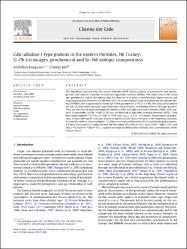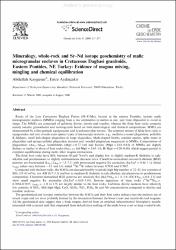Ara
Toplam kayıt 55, listelenen: 31-40
Calc-alkaline I-type plutons in the eastern Pontides, NE Turkey: U–Pb zircon ages, geochemical and Sr–Nd isotopic compositions
(ElsevierGmbH.Allrightsreserved.ElsevierGmbH.Allrightsreserved., 2010-07-28)
Calc-alkaline I-typeplutonsintheeasternPontides,NETurkey: U–Pb zirconages,geochemicalandSr–Ndisotopiccompositions
Late Cretaceous Arc Igneous Activity: The Eğrikar Monzogranite Example
(International Geology Review, 2018)
The geochemical and Sr–Nd–Pb isotope properties, as well as the Laser Ablation Inductively Coupled Plasma and Mass Spectrometry (LA-ICP-MS) U–Pb zircon age, of Eğrikar Monzogranite in the eastern Pontides, are primarily ...
Magmatic evolution of the Calc-alkaline Middle Jurassic igneous rocks in the eastern pontides, NE Turkey: insights from geochemistry, whole-rock Sr-Nd-Pb, in situ zircon Lu-Hf isotopes, and U-Pb geochronology
(Taylor and Francis Ltd., 2023)
The Eastern Pontides in NE Turkey hosts a very limited number of plutonic rocks from the Jurassic period. Here we submit new geochemical, Sr-Nd-Pb and zircon Lu-Hf isotope data, and zircon U-Pb ages for plutonic rocks in ...
Eocene tonalite–granodiorite from the Havza (Samsun) area, northern Turkey: Adakite-like melts of lithospheric mantle and crust generated in a post-collisional settin
(2019-01-14)
Eocene intermediate to felsic plutons of different sizes and compositions are widespread in the Eastern Pontides Orogenic Belt in northern Turkey. Of these, the Taşlık Tepe pluton in the Havza (Samsun) area is fine-to-me ...
Geochronology, geochemistry, and petrogenesis of the Eocene Bayburt intrusions, Eastern Pontide, NE Turkey: implications for lithospheric mantle and lower crustal sources in the high-K calc-alkaline magmatism
(2015-04-28)
Eocene I-type plutons are widespread in the Eastern Pontides, Northeastern Turkey. Geochemical and isotopic results on two Eocene intrusive bodies located in the southern zone of the Eastern Pontides were utilized to achieve ...
Geothermal energy for clean and sustainable development in Turkey
(2019-05-05)
Turkey has a limited amount of fossil fuel reserve, thus is dependent on foreign energy. Approximately 75% of current energy consumption is met by imports. However, Turkey has a high potential of renewables such as biomass, ...
K-Ar dating, whole-rock and Sr-Nd isotope geochemistry of calc-alkaline volcanic rocks around the Gümüşhane area: implications for post-collisional volcanism in the Eastern Pontides, Northeast Turkey
(Springer-Verlag Wien, 2013-05-14)
Volcanic rocks from the Gümüşhane area in the southern part of the Eastern Pontides (NE Turkey) consist mainly of andesitic lava flows associated with tuffs, and rare basaltic dykes. The K-Ar whole-rock dating of these ...
LA-ICP MS zircon dating, whole-rock and Sr–Nd–Pb–O isotope geochemistry of the Camiboğazı pluton, Eastern Pontides, NE Turkey: Implications for lithospheric mantle and lower crustal sources in arc-related I-type magmatism
(Elsevier B.V. All rights reserved, 2014-02-15)
Late Cretaceous I-type plutons arewidespread in the Eastern Pontides,NE Turkey. The studied Camiboğazı pluton is a composite pluton consisting of diorite, tonalite, monzodiorite, monzonite, quartz monzonite, granite, and ...
Mineralogy, whole-rock and Sr–Nd isotope geochemistry of mafic microgranular enclaves in Cretaceous Dagbasi granitoids, Eastern Pontides, NE Turkey: Evidence of magma mixing, mingling and chemical equilibration
(0009-2819/$ - see front matter r 2008 Elsevier GmbH. All rights reserved. doi:10.1016/j.chemer.2008.08.002, 2008-08-04)
Rocks of the Late Cretaceous Dagbasi Pluton (88–83 Ma), located in the eastern Pontides, include mafic microgranular enclaves (MMEs) ranging from a few centimetres to metres in size, and from ellipsoidal to ovoid inshape. ...
Petrogenesis of the late Cretaceous Turnagöl intrusion in the eastern Pontides: Implications for magma genesis in the arc setting
(Production and hosting by Elsevier, 2012-09-28)
A series of Cretaceous plutons is present in the eastern Pontides of northeastern Turkey. The Turnagöl intrusion is the least studied and, thus, the least understood plutons in the orogen. This intrusion consists of ...





















